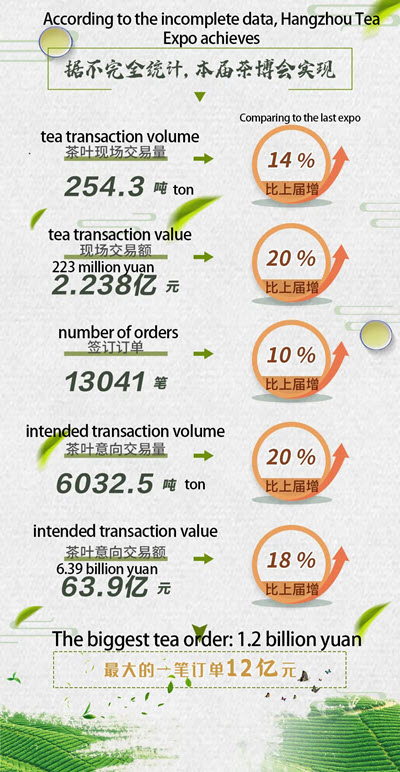Live tea expositions, seminars, and tradeshows are returning with vigor in China. The five-day China International Tea Expo (CTE) that opened in Hangzhou on International Tea Day (May 21) drew a crowd of 152,000 mainly domestic tea buyers. In aggregate they spent RMB6.4 billion purchasing 254 million tons of tea, a 14% increase compared to the previous event. The average value of transactions was up 20% to RMB223 million and orders topped 13,000.

China International Tea Expo
By Dan Bolton
Live tea expositions, seminars, and tradeshows are returning with vigor in China. The China International Tea Expo (CTE) that opened May 21 is the largest live tea industry event since lockdowns force show organizers to cancel in May 2020.
CTE is the largest tea exposition in China. Buyers collectively spent RMB6.4 billion purchasing 254 million tons of tea, a 14% increase compared to the previous event. The average value of transactions was up 20% to RMB223 million and the number of on-site orders topped 13,000. In 2019 there were 10,787 transactions, suggesting pent up demand.
An estimated 152,000 attended, down 18% from the May 2019 third edition of the show which drew a crowd of 185,200. The 2019 expo attracted 3,425 foreign buyers from 46 countries. In addition, there were nearly 200 foreign VIPs from 42 countries and international organizations. In 2021 only a few in-country foreign buyers attended as travel restrictions apply.
In 2019 on-site transactions during the five-day event averaged RMB186 million. Sales totaled RMB5.4 billion for 222.9 tons of tea.
Chinese buyers purchase direct instead of at tea auctions. The largest tea order was valued at $188 million (RMB1.2 billion), according to the Expo and reports in the China Daily newspaper.
There were 3,432 booths on the 750,000 square foot (70,000 square meter) show floor. Buyers numbered 3,600. In May 2019 the expo set up 3,139 booths which included 2,793 tea and coffee related booths.
In 2019 exhibitors representing 25 domestic provinces, cities and districts, numbered 1,563 according to the Hangzhou News
The 2021 show floor was busy with high-value transactions demonstrating a return to normal. Since China is virtually virus free, precautions were not enforced. Attendees wore masks and careful attention was paid to hygiene, ventilation and crowd size.
Special thanks to Coco Xintong Lu who attended the show and provided photos and statistics. Coco is International Business Officer for the Tea Industry Committee, China Association for the Promotion of International Agricultural Cooperation.

Foreign Tea Buyers Face Formidable Restrictions
Foreign guests joined the Opening Ceremony via pre-recorded videos and ambassadors to China, representing several countries, flew from Beijing to Hangzhou. On the show floor the International Pavilion featured 17 booths operated by domestic distributors of international brands.
In China COVID-19 rates are low thanks to an effective test, trace, and isolate policy. The country has reported 103,000 cases with fewer than 5,000 deaths.
China’s borders remain closed to all but residents of these 23 countries. Travelers must provide proof of receiving second of two shots at least 14 days prior to entry and they must present two negative tests PCR and antibody tests, taken within 48 hours of travel. Travelers are checked once again on arrival. Anyone failing the test will be isolated at a government facility. All others quarantine for 14 days, often at home, a approved hotel or government facility. In some regions the requirement is 14+7 (with the last seven days monitored by local community health officials).
Eligible vaccines include the World Health Organization approved Sinovac or vaccines from Pfizer-BioNTech, Moderna, and Johnson & Johnson. Foreign nationals currently in China can travel freely as long as they have the required documents including ID (usually passport) and a green health code. The green code is issued after confirmation of receiving a vaccine using any one of China’s five domestically manufactured vaccines.
Restrictions vary by region depending on community spread. In Guangzhou, the quarantine policy is currently “14+7” (14 days centralized + 7 days community health monitoring). “Some destinations will not accept travelers from medium-risk areas such as Zhangjiajie and Ningxia. Some cities will be cautious about receiving tourists from Guangdong, even if you are not from medium-risk areas,” according to China Highlights.
The government is vaccinating individuals at high rates with goal of 40% of Chinese citizens in June. As of May, 400 million have been vaccinated. China aims to vaccinate up to 80% of its population of more than one billion by the end of 2021 or mid-2022.
The government is vaccinating individuals at high rates with goal of inoculating 40% of Chinese citizens in June. As of May, 400 million have been vaccinated at a pace approaching 10 million daily. China aims to vaccinate 80% of its population of more than one billion by the end of 2021 or mid-2022.
Entry restrictions are not likely to ease until February 2022 just before the Beijing Winter Olympics. The events are scheduled for February 4-20.
? Dan Bolton
Share this post with your colleagues.
Signup and receive Tea Biz weekly in your inbox.
Never Miss an Episode
Subscribe wherever you enjoy podcasts:








